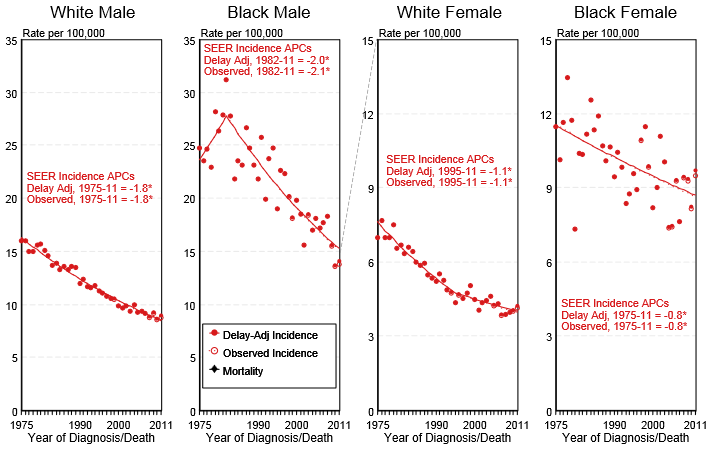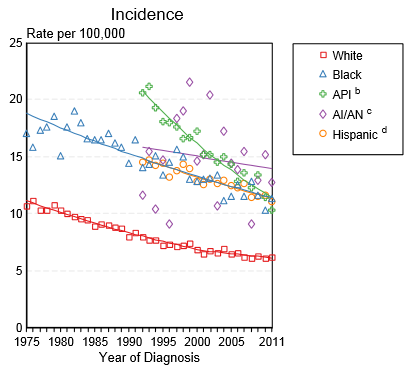Stomach cancer epidemiology and demographics: Difference between revisions
No edit summary |
(Mahshid) |
||
| Line 105: | Line 105: | ||
{{WH}} | {{WH}} | ||
{{WS}} | {{WS}} | ||
[[Category:Up-To-Date]] | |||
[[Category:Oncology]] | |||
[[Category:Medicine]] | |||
[[Category:Gastroenterology]] | |||
[[Category:Surgery]] | |||
Revision as of 16:57, 27 November 2017
Editor-In-Chief: C. Michael Gibson, M.S., M.D. [1]; Associate Editor(s)-in-Chief: Rim Halaby, M.D. [2]
|
Stomach cancer Microchapters |
|
Diagnosis |
|---|
|
Treatment |
|
Case Studies |
|
Stomach cancer epidemiology and demographics On the Web |
|
American Roentgen Ray Society Images of Stomach cancer epidemiology and demographics |
|
Risk calculators and risk factors for Stomach cancer epidemiology and demographics |
Overview
Stomach cancer is the fifth most common cancer worldwide.[1] In the United States, stomach cancer represents roughly 1.3% of all new cancer cases yearly[2]. In 2011, the age-adjusted prevalence of stomach cancer was estimated to be 23.5 cases per 100,000 individuals in the United States.[3] Stomach cancer is two times more common in men than in women, and the incidence increases with age.[4]
Epidemiology and Demographics
Prevalence
- Stomach cancer represents roughly 1.3% of all new cancer cases yearly in the United States.[2]
- In the United States, the age-adjusted prevalence of stomach cancer is 23.5 per 100,000 in 2011.[3]
Incidence
- The worldwide incidence of gastric cancer has declined rapidly over the recent few decades [5-9].
- The delay-adjusted incidence of stomach cancer in 2011 was estimated to be 7.27 per 100,000 persons in the United States.[3]
- In 2011, the age-adjusted incidence of stomach cancer was 7.17 per 100,000 persons in the United States.[3]
- Part of the decline may be due to the recognition of certain risk factors such as H. pylori and other dietary and environmental risks. The decline first took place in countries with low gastric cancer incidence such as the United States while the decline in countries with high incidence like Japan was slower. [10]
- the absolute number of new cases per year is increasing, mainly due to aging in the world population.[16]
Age
- While the overall age-adjusted incidence of stomach cancer in the United States between 2007 and 2011 is 7.5 per 100,000, the age-adjusted incidence of stomach cancer by age category is:[3]
- Under 65 years: 2.9 per 100,000
- 65 and over: 38.8 per 100,000
Gender
- Gastric cancer is more common in men than in women, in both developed and developing countries
- Intestinal gastric cancer is more common in males and older age groups.
- The diffuse or infiltrative type, is equally frequent in both sexes, is more common in younger age groups, and has a worse prognosis than the intestinal type.
- In the United States, the age-adjusted prevalence of stomach cancer by gender in 2011 is:[3]
- In males: 30.3 per 100,000
- In females: 18.2 per 100,000
- In the United States, the delay-adjusted incidence of stomach cancer by gender in 2011 is:[3]
- In males: 9.95 per 100,000 persons
- In females: 5.14 per 100,000 persons
- In the United States, the age-adjusted incidence of stomach cancer by gender on 2011 is:[3]
- In males: 9.82 per 100,000 persons
- In females: 5.06 per 100,000 persons
- Shown below is an image depicting the delay-adjusted incidence and observed incidence of stomach cancer by gender and race in the United States between 1975 and 2011. These graphs are adapted from SEER: The Surveillance, Epidemiology, and End Results Program of the National Cancer Institute.[3]
<figure-inline class="mw-default-size">
Race
- Shown below is a table depicting the age-adjusted prevalence of stomach cancer by race in 2011 in the United States.[3]
| All Races | White | Black | Asian/Pacific Islander | Hispanic | |
| Age-adjusted prevalence | 23.5 per 100,000 | 18.9 per 100,000 | 28.8 per 100,000 | 47.5 per 100,000 | 33.2 per 100,000 |
- Shown below is an image depicting the incidence of stomach cancer by race in the United States between 1975 and 2011.[3]
<figure-inline class="mw-default-size">
API: Asian/Pacific Islander; AI/AN: American Indian/ Alaska Native
Developed Countries
- The incidence of gastric cancer is particularly high in Korea, Japan, Mongolia, central Asia, Eastern Europe, and parts of Central and South America.[4][5]
- Stomach cancer is the most common type of cancer in Korea.[6] It is suspected several risk factors are involved including diet, gastritis, intestinal metaplasia and Helicobacter pylori infection. It is suspected several risk factors are involved including diet, gastritis, intestinal metaplasia and Helicobacter pylori infection. A Korean diet, high in salted, stewed and broiled foods, is thought to be a contributing factor. Ten percent of cases show a genetic component.[7] In Japan and other countries bracken consumption and spores are correlated to stomach cancer incidence.[8]
GEOGRAPHICAL VARIATION
- Rates are highest in Eastern Asia, Eastern Europe, and South America, while the lowest rates are in North America and parts of Africa [1]. Over 70 percent of gastric cancers occur in developing countries [1]. Studies of Japanese migrants to the Unites States have confirmed that early exposure to environmental rather than genetic factors have a greater influence on mortality and incidence rates [25,26].
Mortality
- demonstrated an annual percent change (APC) in gastric mortality rate around -3 to -4 percent for the major European countries. The APC rates were similar for the Republic of Korea (-4.3 percent), Japan (-3.5 percent), Australia (-3.7 percent), and the United States (-3.6 percent). In Latin America, the decline was less marked, but constant (-1.6 to -2.6 percent) [33].
- For the past few decades, gastric cancer mortality has decreased markedly in most areas of the world[29,30]. However, gastric cancer remains a disease of poor prognosis and high mortality, second only to lung cancer as the leading cause of cancer-related death worldwide. In general, countries with higher incidence rates of gastric cancer show better survival rates than countries with lower incidence[31]. This association is largely due to a difference in survival rates based on tumor location within the stomach. Tumors located in the gastric cardia have a much poorer prognosis compared to those in the pyloric antrum, with lower 5-year survival and higher operative mortality[32]. In addition, the availability of screening for early detection in high-risk areas has led to a decrease in mortality. In Japan where mass screening programs are in place, mortality rates for gastric cancer in men have more than halved since the early 1970s[33]. When disease is confined to the inner lining of the stomach wall, 5-year survival is on the order of 95%. In contrast, few gastric cancers are discovered at an early stage in US, leading to 5-year relative survival rates of less than 20%[34]. Similarly in European countries, the 5-year relative survival rates for gastric cancer vary from 10% to 20%[35,36]. Host-related factors may also affect prognosis, as a US study demonstrated that gastric cancers in persons of Asian descent had a better prognosis compared to non-Asians[37].
Percent Distribution of stomach cancer by Histology
Among patients with histologically confirmed cases of stomach cancer, the percent distribution of the types of the disease between YEAR and YEAR in the United States are:[3]
- Epidermoid carcinoma: 0.9%
- Squamous cell carcinoma: 0.8%
- Adenocarcinoma: 83.7%
- Adenocarcinoma not otherwise specified: 48.3%
- Adenocarcinoma, intestinal type: 8.4%
- Adenocarcinoma, diffuse type: 3.5%
- Linitis plastica: 0.6%
- Mucinous adenocarcinoma: 1.4%
- Mucin producing adenocarcinoma: 0.5%
- Signet ring adenocarcinoma: 16.8%
- Other adenocarcinoma: 4.1%
- Other specific carcinoma: 6.3%
- Unspecified carcinoma: 2.5%
- Sarcoma and other soft tissue tumors: 0.3%
- Other specific type: 6%
- Unspecified: 0.5%
References
- ↑ Stomach cancer incidence statistics. Cancer research UK
- ↑ 2.0 2.1 SEER stat fact sheets: stomach cancer
- ↑ 3.00 3.01 3.02 3.03 3.04 3.05 3.06 3.07 3.08 3.09 3.10 3.11 Howlader N, Noone AM, Krapcho M, Garshell J, Miller D, Altekruse SF, Kosary CL, Yu M, Ruhl J, Tatalovich Z,Mariotto A, Lewis DR, Chen HS, Feuer EJ, Cronin KA (eds). SEER Cancer Statistics Review, 1975-2011, National Cancer Institute. Bethesda, MD, http://seer.cancer.gov/csr/1975_2011/, based on November 2013 SEER data submission, posted to the SEER web site, April 2014.
- ↑ 4.0 4.1 Brenner H, Rothenbacher D, Arndt V (2009). "Epidemiology of stomach cancer". Methods Mol Biol. 472: 467–77. doi:10.1007/978-1-60327-492-0_23. PMID 19107449.
- ↑ Shin A, Kim J, Park S (2011). "Gastric cancer epidemiology in Korea". J Gastric Cancer. 11 (3): 135–40. doi:10.5230/jgc.2011.11.3.135. PMC 3204471. PMID 22076217.
- ↑ Jung KW, Park S, Kong HJ, Won YJ, Lee JY, Park EC; et al. (2011). "Cancer statistics in Korea: incidence, mortality, survival, and prevalence in 2008". Cancer Res Treat. 43 (1): 1–11. doi:10.4143/crt.2011.43.1.1. PMC 3072529. PMID 21509157.
- ↑ AHyuk-Joon Lee, Han-Kwang Yang, Yoon-Ok Ahn, Gastric cancer in Korea Gastric Cancer, Volume 5, Number 3 / September, 2002. DOI:10.1007/s101200200031]
- ↑ Alonso-Amelot ME, Avendano M., Human Carcinogenesis and Bracken Fern: A Review of the Evidence, Curr Med Chem. 2002 Mar;9(6):675-86